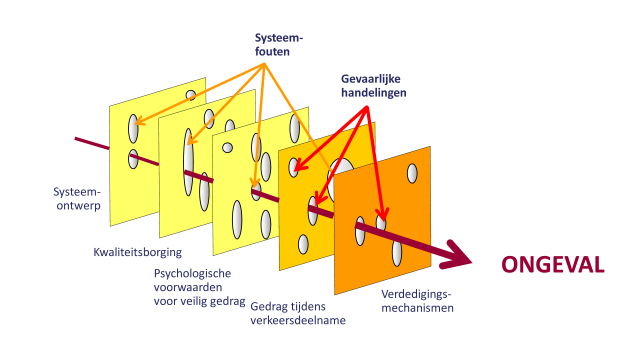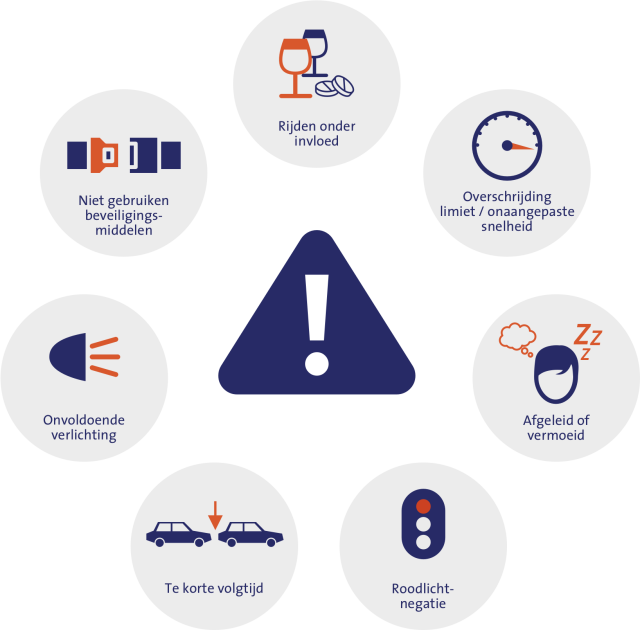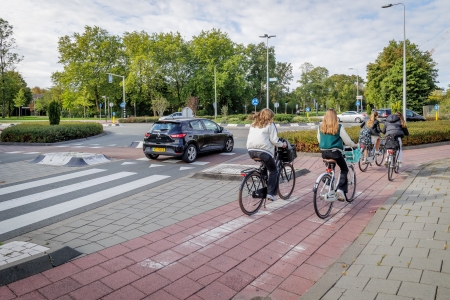Hieronder vindt u de lijst met referenties uit deze factsheet; alle bronnen zijn in te zien of op te vragen. Via Publicaties vindt u, naast de hier gebruikte bronnen, nog een uitgebreide collectie aan literatuur op het gebied van verkeersveiligheid.
[1]. Singh, S. (2018). Critical reasons for crashes investigated in the National Motor Vehicle Crash Causation Survey. Traffic Safety Facts Crash • Stats. Report No. DOT HS 812 506. National Highway Traffic Safety Administration, Washington DC.
[2]. Aarts, L.T. & Dijkstra, A. (2018). DV3 - Achtergronden en uitwerking van de verkeersveiligheidsvisie. De visie Duurzaam Veilig Wegverkeer voor de periode 2018 – 2030 onderbouwd. R-2018-6B. SWOV, Den Haag.
[3]. Reason, J., Manstead, A., Stradling, S., Baxter, J., et al. (1990). Errors and violations on the road: a real distinction? In: Ergonomics, vol. 33, nr. 10/11, p. 1315-1332.
[4]. SWOV & CROW (2021). Handreiking gedragsverandering in het verkeer. KN SPV 2021-4. Kennisnetwerk SPV, Utrecht.
[5]. Weijermars, W., Stipdonk, H., Aarts, L., Bos, N., et al. (2014). Verkeersveiligheidsbalans 2000-2012. Oorzaken en gevolgen van verkeersonveiligheid. R-2014-24. SWOV, Den Haag.
[6]. Weijermars, W.A.M. & Schagen, I.N.L.G. van (2009). Tien jaar Duurzaam Veilig. Verkeersveiligheidsbalans 1998-2007. R-2009-14. SWOV, Leidschendam.
[7]. Shinar, D. (2019). Crash causes, countermeasures, and safety policy implications. In: Accident Analysis & Prevention, vol. 125, p. 224-234.
[8]. Knaap, P. van der (2021). Verkeer is ‘gedrag’, maar verkeersveiligheid is méér dan ‘gedrag’. De effecten van voorlichting en educatie worden makkelijk overschat zolang goede evaluatie uitblijft. In: Verkeerskunde, vol. 72, nr. 2, p. 18-19.
[9]. Webb, T.L. & Sheeran, P. (2006). Does changing behavioral intentions engender behavior change? A meta-analysis of the experimental evidence. In: Psychological Bulletin, vol. 132, nr. 2, p. 249-268.
[10]. Thomas, F.D., Rilea, S., Blomberg, R.D., Peck, R.C., et al. (2016). Evaluation of the safety benefits of the risk awareness and perception training program for novice teen drivers. DOT HS 812 235. National Highway Traffic Safety Administration NHTSA, Washington, D.C.
[11]. Fisher, D.L., Agrawal, R., Divekar, G., Hamid, M.A., et al. (2024). Novice driver crashes: The relation between putative causal factors, countermeasures, real world implementations, and policy – A case study in simple, scalable solutions. In: Accident Analysis & Prevention, vol. 198, p. 107397.
[12]. Senserrick, T., Ivers, R., Boufous, S., Chen, H.-Y., et al. (2009). Young driver education programs that build resilience have potential to reduce road crashes. In: Pediatrics, vol. 124, nr. 5, p. 1287-1292.
[13]. Senserrick, T., Möller, H., Rogers, K., Cullen, P., et al. (2021). Youth resilience education and 13-year motor vehicle crash risk. In: Pediatrics, vol. 148, nr. 6.
[14]. Duperrex, O., Bunn, F. & Roberts, I. (2002). Safety education of pedestrians for injury prevention: a systematic review of randomised controlled trials. In: British Medical Journal, vol. 324, nr. 7346, p. 1129-1131.
[15]. Twisk, D.A.M., Vlakveld, W.P. & Commandeur, J.J.F. (2007). Wanneer is verkeerseducatie effectief? Systematische evaluatie van educatieprojecten. R-2006-28. SWOV, Leidschendam.
[16]. Twisk, D.A.M., Vlakveld, W.P., Commandeur, J.J.F., Shope, J.T., et al. (2014). Five road safety education programmes for young adolescent pedestrians and cyclists: A multi-programme evaluation in a field setting. In: Accident Analysis & Prevention, vol. 66, p. 55-61.
[17]. Bishop, D.T., Dkaidek, T.S., Atanasova, G. & Broadbent, D.P. (2022). Improving children’s on-road cycling with immersive video-based training: A pilot study. In: Transportation Research Interdisciplinary Perspectives, vol. 16, p. 100699.
[18]. Box, E. & Dorn, L. (2023). A cluster randomised controlled trial (cRCT) evaluation of a pre-driver education intervention using the Theory of Planned Behaviour. In: Transportation Research Part F: Traffic Psychology and Behaviour, vol. 94, p. 379-397.
[19]. Kovácsová, N., Vlakveld, W.P., de Winter, J.C.F. & Hagenzieker, M.P. (2020). PC-based hazard anticipation training for experienced cyclists: Design and evaluation. In: Safety Science, vol. 123, p. 104561.
[20]. Kint, S.T. van der, Schermers, G., Gebhard, S.E. & Hermens, F. (2022). Veilige Snelheden, Geloofwaardige Snelheidslimieten (VSGS). Hoe valide is de GS-bepaling met de VSGS-methode? R-2022-5. SWOV, Den Haag.
[21]. Gregersen, N.P. & Nolén, S. (1994). Children's road safety and the strategy of voluntary traffic safety clubs. In: Accident Analysis & Prevention, vol. 26, nr. 4, p. 463-470.
[22]. Feenstra, H., Ruiter, R.A.C. & Kok, G. (2014). Evaluating traffic informers: Testing the behavioral and social-cognitive effects of an adolescent bicycle safety education program. In: Accident Analysis & Prevention, vol. 73, p. 288-295.
[23]. Delhomme, P., Dobbeleer, W. de, Forward, S., Simões, A., et al. (2009). Manual for designing, implementing, and evaluating road safety communication campaigns. Campaigns and Awareness Raising Strategies in Traffic Safety (CAST), Brussels.
[24]. Phillips, R.O., Ulleberg, P. & Vaa, T. (2011). Meta-analysis of the effect of road safety campaigns on accidents. In: Accident Analysis & Prevention, vol. 43, nr. 3, p. 1204-1218.
[25]. Fisa, R., Musukuma, M., Sampa, M., Musonda, P., et al. (2022). Effects of interventions for preventing road traffic crashes: an overview of systematic reviews. In: BMC Public Health, vol. 22, nr. 1, p. 513.
[26]. Faus, M., Alonso, F., Fernández, C. & Useche, S.A. (2021). Are traffic announcements really effective? A systematic review of evaluations of crash-prevention communication campaigns. In: Safety, vol. 7, nr. 4, p. 66.
[27]. Kremers, S. & Munnik, Z. (2022). Campagne-effectonderzoek MONO automobilisten en fietsers DVJ Insights. In opdracht van het Ministerie van Infrastructuur en Waterstaat, Utrecht.
[28]. Groot-Mesken, J. de & Vlakveld, W.P. (2014). Een duwtje in de goede richting - verkeersveilig gedrag : hoe kan verkeersveiligheidsbeleid profiteren van inzichten rondom automatische gedragsbeïnvloeding? R-2014-13. SWOV, Den Haag.
[29]. Ljung Aust, M., Baldanzini, N., Bakker, B., Berghaus, M., et al. (2020). Final Measures. Deliverable D5.5 of the H2020 project MeBeSafe. European Commission, Brussels.
[30]. Bell, J.L., Taylor, M.A., Chen, G.X., Kirk, R.D., et al. (2017). Evaluation of an in-vehicle monitoring system (IVMS) to reduce risky driving behaviors in commercial drivers: Comparison of in-cab warning lights and supervisory coaching with videos of driving behavior. In: Journal of Safety Research, vol. 60, p. 125-136.
[31]. Dijksterhuis, C., Lewis-Evans, B., Jelijs, B., Waard, D. de, et al. (2015). The impact of immediate or delayed feedback on driving behaviour in a simulated Pay-As-You-Drive system. In: Accident Analysis and Prevention, vol. 75, p. 93-104.
[32]. Farah, H., Musicant, O., Shimshoni, Y., Toledo, T., et al. (2014). Can providing feedback on driving behavior and training on parental vigilant care affect male teen drivers and their parents? In: Accident Analysis & Prevention, vol. 69, p. 62-70.
[33]. Peer, S., Muermann, A. & Sallinger, K. (2020). App-based feedback on safety to novice drivers: Learning and monetary incentives. In: Transportation Research Part F: Traffic Psychology and Behaviour, vol. 71, p. 198-219.
[34]. Stevenson, M., Harris, A., Wijnands, J.S. & Mortimer, D. (2021). The effect of telematic based feedback and financial incentives on driving behaviour: A randomised trial. In: Accident Analysis & Prevention, vol. 159, p. 106278.
[35]. Vlakveld, W. (2018). Notitie Monitor- en Feedbacksystemen. Literatuurstudie naar de effecten van monitor- en feedbacksystemen op het rijgedrag. R-2018-26. SWOV, Den Haag.
[36]. Toledo, T. & Lotan, T. (2006). In-Vehicle Data Recorder for Evaluation of Driving Behavior and Safety. In: Transportation Research Record, vol. 1953, nr. 1, p. 112-119.
[37]. Farmer, C.M., Kirley, B.B. & McCartt, A.T. (2010). Effects of in-vehicle monitoring on the driving behavior of teenagers. In: Journal of Safety Research, vol. 41, nr. 1, p. 39-45.
[38]. McNally, B. & Bradley, G.L. (2018). Predicting young, novice drivers’ intentions to install in-vehicle data recorders. In: Transportation Research Part F: Traffic Psychology and Behaviour, vol. 59, p. 401-417.
[39]. Al-Hussein, W.A., Kiah, M.L.M., Por, L.Y. & Zaidan, B.B. (2021). A systematic review on sensor-based driver behaviour studies: coherent taxonomy, motivations, challenges, recommendations, substantial analysis and future directions. In: PeerJ Computer Science, vol. 7.
[40]. Bolderdijk, J.W., Knockaert, J., Steg, E.M. & Verhoef, E.T. (2011). Effects of Pay-As-You-Drive vehicle insurance on young drivers’ speed choice: Results of a Dutch field experiment. In: Accident Analysis & Prevention, vol. 43, nr. 3, p. 1181-1186.
[41]. ANWB (2019). ANWB Veilig Rijden rapport 2019. ANWB, Den Haag.
[42]. Elvik, R. (2014). Rewarding safe and environmentally sustainable driving: systematic review of trials. In: Transportation Research Record, vol. 2465, nr. 1, p. 1-7.
[43]. Pugnetti, C. & Elmer, S. (2020). Self-assessment of driving style and the willingness to share personal information. In: Journal of Risk and Financial Management, vol. 13, nr. 3, p. 53.
[44]. Malin, F. & Luoma, J. (2020). Effects of speed display signs on driving speed at pedestrian crossings on collector streets. In: Transportation Research Part F: Traffic Psychology and Behaviour, vol. 74, p. 433-438.
[45]. Karimpour, A., Kluger, R., Liu, C. & Wu, Y.-J. (2021). Effects of speed feedback signs and law enforcement on driver speed. In: Transportation Research Part F: Traffic Psychology and Behaviour, vol. 77, p. 55-72.
[46]. Groot-Mesken, J. de, Wijnen, W., Stelling-Konczak, A. & Commandeur, J.J.F. (2016). Interpolis SlimOpWeg-programma: de AutoModus-app. Vragenlijstonderzoek naar het effect van een app om smartphonegebruik in de auto te verminderen. R-2016-3. SWOV, Den Haag.
[47]. Stelling-Kończak, A., Hermens, F. & Kint, S.T. van der (2019). Effectiviteit van een app tegen smartphonegebruik op de fiets. Evaluatiestudie van de PhoNo-app. R-2019-27. SWOV, Den Haag.
[48]. Carpenter, C.J. (2019). Cognitive dissonance, ego-involvement, and motivated reasoning. In: Annals of the International Communication Association, vol. 43, nr. 1, p. 1-23.
[49]. Kelly, M.P. & Barker, M. (2016). Why is changing health-related behaviour so difficult? In: Public Health, vol. 136, p. 109-116.
[50]. Urbina, D.A. & Ruiz-Villaverde, A. (2019). A critical review of Homo Economicus from five approaches. In: American Journal of Economics and Sociology, vol. 78, nr. 1, p. 63-93.
[51]. Sheeran, P. & Webb, T.L. (2016). The Intention–Behavior Gap. In: Social and Personality Psychology Compass, vol. 10, nr. 9, p. 503-518.
[52]. Musselwhite, C., Avineri, E., Susilo, Y., Fulche, E., et al. (2010). Understanding public attitudes to road user safety. Road Safety Research Report No. 111. Centre for Transport & Society, University of the West of England, Bristol.
[53]. La Barbera, F. & Ajzen, I. (2020). Control interactions in the Theory of Planned Behavior: Rethinking the role of subjective norm. In: Europe's Journal of Psychology, vol. 16, nr. 3, p. 401-417.
[54]. Dijksterhuis, A. (2003). Automaticiteit en controle. In: Vonk, R. (red.), Cognitieve sociale psychologie. Psychologie van het dagelijks denken en doen. Lemma, Utrecht.
[55]. Hoekstra, A.T.G., Twisk, D.A.M., Stelling, A. & Houtenbos, M. (2013). Gebruik van mobiele apparatuur door fietsende jongeren. Bouwstenen voor effectieve maatregelen. R-2013-12. SWOV, Leidschendam.
[56]. Vlakveld, W., Goldenbeld, C., Knapper, A. & Bax, C.A. (2014). Veiligheidscultuur in het wegtransport. R-2014-12. SWOV, Den Haag.




